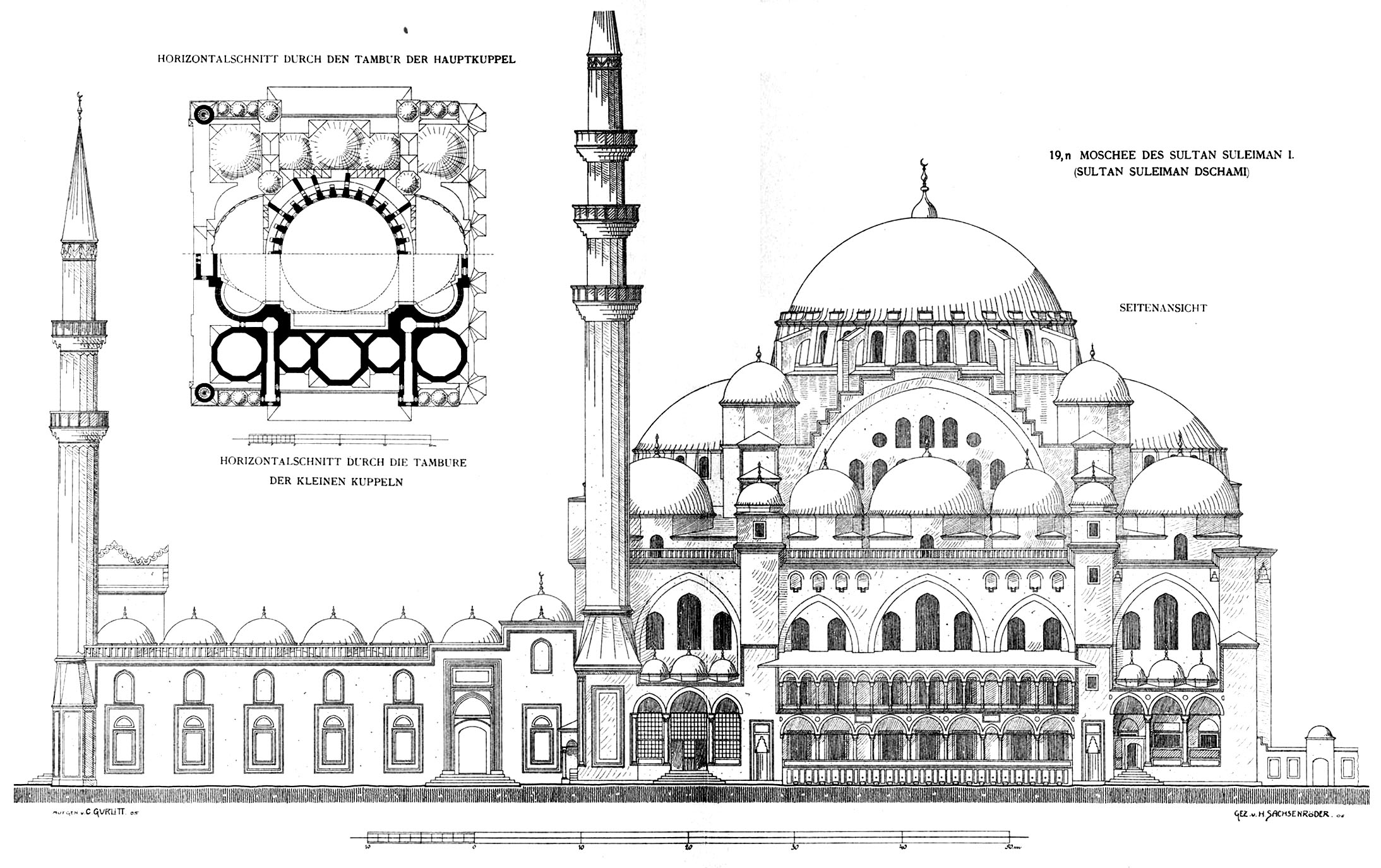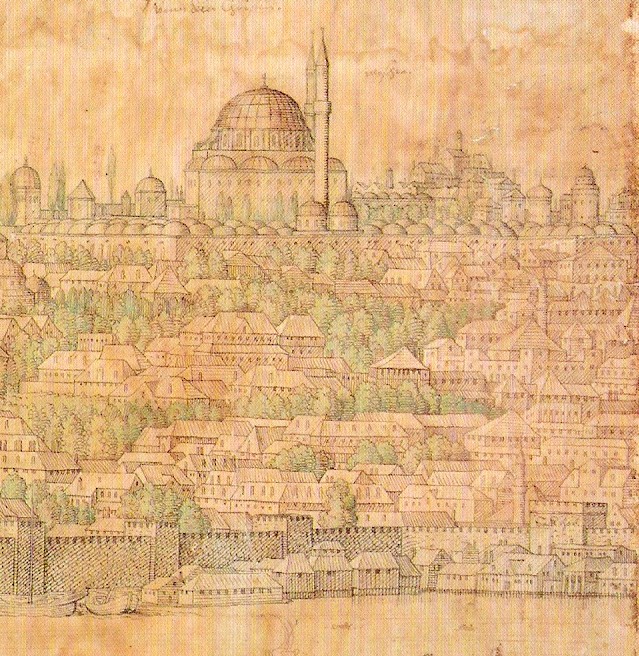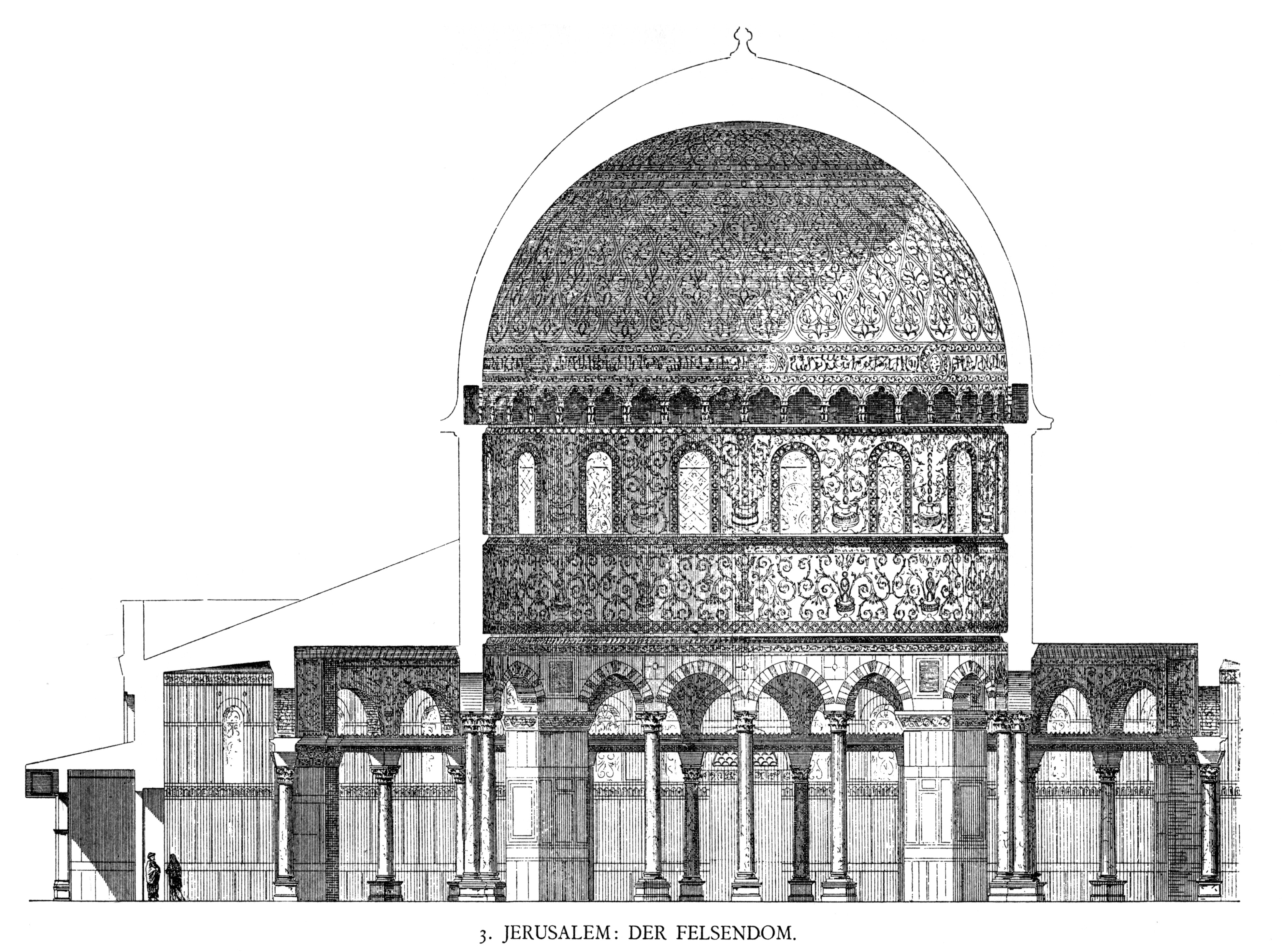|
Süleymaniye Mosque
The Süleymaniye Mosque ( tr, Süleymaniye Camii, ) is an Ottoman imperial mosque located on the Third Hill of Istanbul, Turkey. The mosque was commissioned by Suleiman the Magnificent and designed by the imperial architect Mimar Sinan. An inscription specifies the foundation date as 1550 and the inauguration date as 1557. Behind the ''qibla'' wall of the mosque is an enclosure containing the separate octagonal mausoleums of Suleiman the Magnificent and his wife Hurrem Sultan (Roxelana). For 462 years, the Süleymaniye Mosque was the largest mosque in the city, until it was surpassed by the Çamlıca Mosque in 2019. The Süleymaniye Mosque is one of the best-known sights of Istanbul, and from its location on the Third Hill, it commands an extensive view of the city around the Golden Horn. History Sultan Suleyman the Magnificent chose the architect Mimar Sinan to create a mosque in memory of his son Şehzade (Crown Prince) Mehmed. Suleyman was so impressed with the ensuing ... [...More Info...] [...Related Items...] OR: [Wikipedia] [Google] [Baidu] |
Golden Horn
The Golden Horn ( tr, Altın Boynuz or ''Haliç''; grc, Χρυσόκερας, ''Chrysókeras''; la, Sinus Ceratinus) is a major urban waterway and the primary inlet of the Bosphorus in Istanbul, Turkey. As a natural estuary that connects with the Bosphorus Strait at the point where the strait meets the Sea of Marmara, the waters of the Golden Horn help define the northern boundary of the peninsula constituting "Old Istanbul" (ancient Byzantium and Constantinople), the tip of which is the promontory of Sarayburnu, or Seraglio Point. This estuarial inlet geographically separates the historic center of Istanbul from the rest of the city, and forms a horn-shaped, sheltered harbor that in the course of history has protected Greek, Roman, Byzantine, Ottoman and other maritime trade ships for thousandsBBC: "Ista ... [...More Info...] [...Related Items...] OR: [Wikipedia] [Google] [Baidu] |
Şehzade Mosque
The Şehzade Mosque ( tr, Şehzade Camii, from the original Persian شاهزاده ''Šāhzādeh'', meaning "prince") is a 16th-century Ottoman imperial mosque located in the district of Fatih, on the third hill of Istanbul, Turkey. It was commissioned by Suleiman the Magnificent as a memorial to his son Şehzade Mehmed who died in 1543. It is sometimes referred to as the "Prince's Mosque" in English.Rogers, Sinan, pp. index In a June 2016 attack, the windows of the mosque were shattered. History The construction of the Şehzade Complex (''külliye'') was ordered by the Ottoman Sultan Suleiman the Magnificent as a memorial to his favorite son Şehzade Mehmed (born 1521) who died in 1543 while returning to Istanbul after a victorious military campaign in Hungary. Mehmed was the eldest son of Suleiman's only legal wife Hürrem Sultan - although not his eldest son - and before his untimely death he was primed to accept the sultanate following Suleiman's reign. Suleiman is said to ... [...More Info...] [...Related Items...] OR: [Wikipedia] [Google] [Baidu] |
1766 Istanbul Earthquake
The 1766 Istanbul earthquake was a strong earthquake with epicenter in the eastern part of the Sea of Marmara, in the Çınarcık Basin (or near the Princes' Islands, north of the basin) which occurred in the early hours of Thursday morning, 22 May 1766. The earthquake had an estimated magnitude of 7.1 on the surface wave magnitude scale, and caused effects in a vast area extending from Izmit to Rodosto (now Tekirdağ). In this area, the earthquake was followed by a tsunami which caused significant damage. The earthquake of 1766 was the last major earthquake to rock Constantinople (now known in English under its Turkish name, Istanbul) because of a rupture of the North Anatolian Fault in the Marmara region. Geology The Sea of Marmara is a pull-apart basin formed at a releasing bend in the North Anatolian Fault ("NAF"), a right-lateral strike-slip fault. East of the Sea of Marmara the NAF splits in three major branches; while the sinuous southern branch goes inland in directio ... [...More Info...] [...Related Items...] OR: [Wikipedia] [Google] [Baidu] |
Mehmed IV
Mehmed IV ( ota, محمد رابع, Meḥmed-i rābi; tr, IV. Mehmed; 2 January 1642 – 6 January 1693) also known as Mehmed the Hunter ( tr, Avcı Mehmed) was the Sultan of the Ottoman Empire from 1648 to 1687. He came to the throne at the age of six after his father was overthrown in a coup. Mehmed went on to become the second longest reigning sultan in Ottoman history after Suleiman the Magnificent. While the initial and final years of his reign were characterized by military defeat and political instability, during his middle years he oversaw the revival of the empire's fortunes associated with the Köprülü era. Mehmed IV was known by contemporaries as a particularly pious ruler, and was referred to as gazi, or "holy warrior" for his role in the many conquests carried out during his long reign. Under Mehmed IV's reign the empire reached the height of its territorial expansion in Europe. From a young age he developed a keen interest in hunting, for which he is known as ... [...More Info...] [...Related Items...] OR: [Wikipedia] [Google] [Baidu] |
Great Fire Of 1660
Two thirds of Constantinople (now Istanbul) were destroyed in the Great Fire of 1660. The chronicler Abdi Paşa estimated that the fire destroyed 280,000 houses and burned for approximately forty-nine hours. During the reconstruction of the city, the Ottomans enacted unprecedented policies concerning Christian and Jewish houses of worship. In previous periods, the Ottomans had usually allowed the rebuilding of churches and synagogues. However, in this period they didn't. Background On July 24, 1660, there was a great fire in Constantinople. It destroyed two thirds of the city. Seven synagogues and at least 25 churches burned to the ground. Contemporary sources have written that thousands of homes were caught in the blaze. The fire began west of Eminönü and destroyed densely populated neighborhoods with old-fashioned wooden homes. Abdi Paşa tells us that the fire "marched across the city like an invading army." Contemporary sources estimate that 280,000 homes were destroyed and ... [...More Info...] [...Related Items...] OR: [Wikipedia] [Google] [Baidu] |
Hagia Sophia
Hagia Sophia ( 'Holy Wisdom'; ; ; ), officially the Hagia Sophia Grand Mosque ( tr, Ayasofya-i Kebir Cami-i Şerifi), is a mosque and major cultural and historical site in Istanbul, Turkey. The cathedral was originally built as a Greek Orthodox Church, Greek Orthodox church which lasted from 360 AD until the Fall of Constantinople, conquest of Constantinople by the Ottoman Empire in 1453. It served as a mosque until 1935, when it became a museum. In 2020, the site once again became a mosque. The current structure was built by the eastern Roman emperor Justinian I as the Christian cathedral of Constantinople for the state church of the Roman Empire between 532 and 537, and was designed by the Greeks, Greek geometers Isidore of Miletus and Anthemius of Tralles. It was formally called the Church of the Holy Wisdom () and upon completion became the world's largest interior space and among History of Roman and Byzantine domes, the first to employ a fully pendentive dome. It is co ... [...More Info...] [...Related Items...] OR: [Wikipedia] [Google] [Baidu] |
Justinian I
Justinian I (; la, Iustinianus, ; grc-gre, Ἰουστινιανός ; 48214 November 565), also known as Justinian the Great, was the Byzantine emperor from 527 to 565. His reign is marked by the ambitious but only partly realized ''renovatio imperii'', or "restoration of the Empire". This ambition was expressed by the partial recovery of the territories of the defunct Western Roman Empire. His general, Belisarius, swiftly conquered the Vandal Kingdom in North Africa. Subsequently, Belisarius, Narses, and other generals conquered the Ostrogothic kingdom, restoring Dalmatia, Sicily, Italian peninsula, Italy, and Rome to the empire after more than half a century of rule by the Ostrogoths. The Liberius (praetorian prefect), praetorian prefect Liberius reclaimed the south of the Iberian peninsula, establishing the province of Spania. These campaigns re-established Roman control over the western Mediterranean, increasing the Empire's annual revenue by over a million Solidus (coin) ... [...More Info...] [...Related Items...] OR: [Wikipedia] [Google] [Baidu] |
Jerusalem
Jerusalem (; he, יְרוּשָׁלַיִם ; ar, القُدس ) (combining the Biblical and common usage Arabic names); grc, Ἱερουσαλήμ/Ἰεροσόλυμα, Hierousalḗm/Hierosóluma; hy, Երուսաղեմ, Erusałēm. is a city in Western Asia. Situated on a plateau in the Judaean Mountains between the Mediterranean Sea, Mediterranean and the Dead Sea, it is one of the List of oldest continuously inhabited cities, oldest cities in the world and is considered to be a holy city for the three major Abrahamic religions: Judaism, Christianity, and Islam. Both Israelis and Palestinians claim Jerusalem as their Capital city, capital, as Israel maintains its primary governmental institutions there and the State of Palestine ultimately foresees it as its seat of power. Because of this dispute, Status of Jerusalem, neither claim is widely recognized internationally. Throughout History of Jerusalem, its long history, Jerusalem has been destroyed at least twice, Sie ... [...More Info...] [...Related Items...] OR: [Wikipedia] [Google] [Baidu] |
Temple Of Solomon
Solomon's Temple, also known as the First Temple (, , ), was the Temple in Jerusalem between the 10th century BC and . According to the Hebrew Bible, it was commissioned by Solomon in the United Kingdom of Israel before being inherited by the Kingdom of Judah in . It stood for around four centuries until it was destroyed by the Neo-Babylonian Empire during the Babylonian siege of Jerusalem, which occurred under the reign of Babylonian king Nebuchadnezzar II. Although most modern scholars agree that the First Temple existed on the Temple Mount in Jerusalem by the time of the Babylonian siege, there is significant debate over the date of its construction and the identity of its builder. The Hebrew Bible, specifically within the Book of Kings, includes a detailed narrative about the construction's ordering by Solomon, the penultimate ruler of amalgamated Israel and Judah. It further credits Solomon as the placer of the Ark of the Covenant in the Holy of Holies, a windowless ... [...More Info...] [...Related Items...] OR: [Wikipedia] [Google] [Baidu] |
Dome Of The Rock
The Dome of the Rock ( ar, قبة الصخرة, Qubbat aṣ-Ṣakhra) is an Islamic shrine located on the Temple Mount in the Old City of Jerusalem, a site also known to Muslims as the ''al-Haram al-Sharif'' or the Al-Aqsa Compound. Its initial construction was undertaken by the Umayyad Caliphate on the orders of Abd al-Malik during the Second Fitna in 691–692 CE, and it has since been situated on top of the site of the Second Jewish Temple (built in to replace the destroyed Solomon's Temple), which was destroyed by the Romans in 70 CE. The original dome collapsed in 1015 and was rebuilt in 1022–23. The Dome of the Rock is the world's oldest surviving work of Islamic architecture. Its architecture and mosaics were patterned after nearby Byzantine churches and palaces, although its outside appearance was significantly changed during the Ottoman period and again in the modern period, notably with the addition of the gold-plated roof, in 1959–61 and again in 1993. The ... [...More Info...] [...Related Items...] OR: [Wikipedia] [Google] [Baidu] |
Solomon
Solomon (; , ),, ; ar, سُلَيْمَان, ', , ; el, Σολομών, ; la, Salomon also called Jedidiah ( Hebrew: , Modern: , Tiberian: ''Yăḏīḏăyāh'', "beloved of Yah"), was a monarch of ancient Israel and the son and successor of David, according to the Hebrew Bible and the Old Testament. He is described as having been the penultimate ruler of an amalgamated Israel and Judah. The hypothesized dates of Solomon's reign are 970–931 BCE. After his death, his son and successor Rehoboam would adopt harsh policy towards the northern tribes, eventually leading to the splitting of the Israelites between the Kingdom of Israel in the north and the Kingdom of Judah in the south. Following the split, his patrilineal descendants ruled over Judah alone. The Bible says Solomon built the First Temple in Jerusalem, dedicating the temple to Yahweh, or God in Judaism. Solomon is portrayed as wealthy, wise and powerful, and as one of the 48 Jewish prophets. He is also ... [...More Info...] [...Related Items...] OR: [Wikipedia] [Google] [Baidu] |
Thuluth
''Thuluth'' ( ar, ثُلُث, ' or ar, خَطُّ الثُّلُثِ, '; fa, ثلث, ''Sols''; Turkish: ''Sülüs'', from ' "one-third") is a script variety of Islamic calligraphy. The straight angular forms of Kufic were replaced in the new script by curved and oblique lines. In ''Thuluth'', one-third of each letter slopes, from which the name (meaning "a third" in Arabic) comes. An alternative theory to the meaning is that the smallest width of the letter is one third of the widest part. It is an elegant, cursive script, used in medieval times on mosque decorations. Various calligraphic styles evolved from ''Thuluth'' through slight changes of form. History The greatest contributions to the evolution of the ''Thuluth'' script occurred in the Ottoman Empire in three successive steps that Ottoman art historians call "calligraphical revolutions": *The first revolution occurred in the 15th century and was initiated by the master calligrapher Sheikh Hamdullah. *The second revoluti ... [...More Info...] [...Related Items...] OR: [Wikipedia] [Google] [Baidu] |





.jpg)



